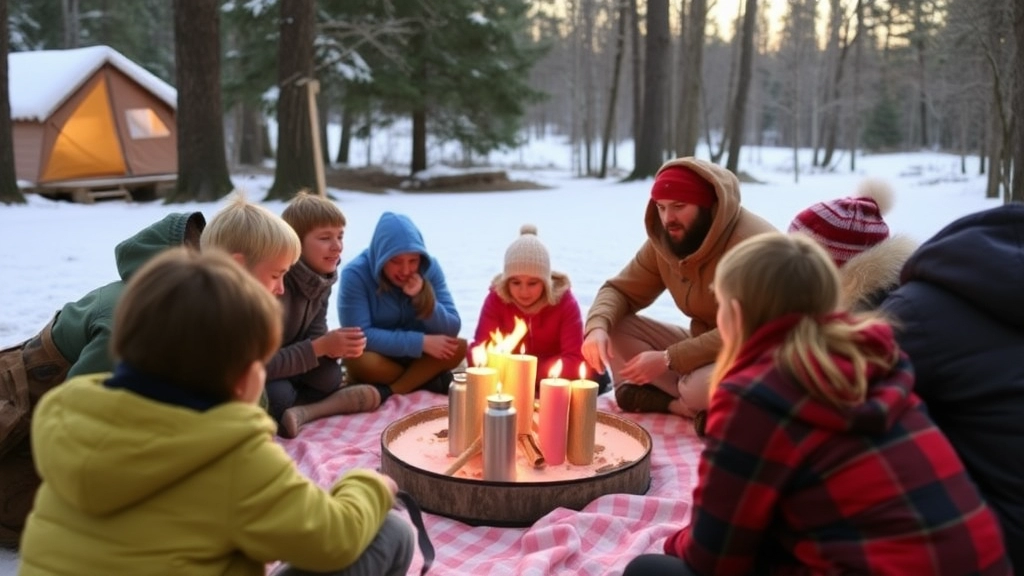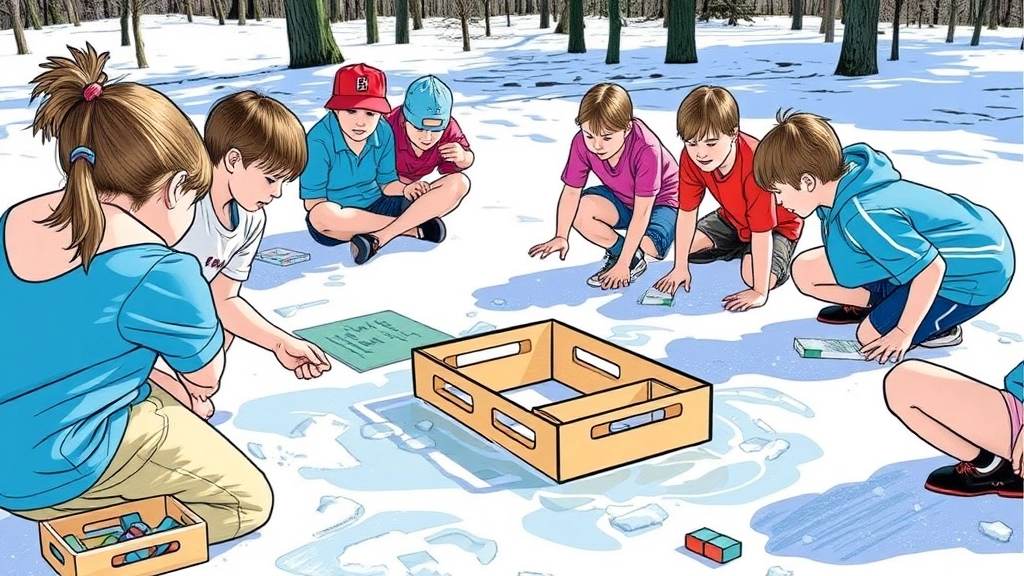Summer Camp Ice Breaker Games
Summer camp is all about making new friends and creating unforgettable memories. One of the best ways to kick things off is with some engaging Summer Camp Ice Breaker Games. These activities are perfect for breaking down barriers and getting everyone comfortable with each other. Whether you’re working with small groups or large teams, there’s an icebreaker game to suit every setting.
From quick and easy games that require minimal setup to more interactive activities that encourage teamwork, there’s something for everyone. You can even use everyday objects to spark creativity and conversation. The key is to keep it fun and engaging, ensuring that campers start their adventure on the right foot. Dive into these icebreaker ideas and watch as your campers bond and create lasting friendships.
Fun Icebreakers for Small Groups
Ever been in a small group and felt that awkward silence? Yeah, we’ve all been there. Breaking the ice can be a real challenge, but it’s crucial for setting the tone and getting everyone comfortable. So, what can you do to get everyone chatting and laughing in no time? Let me walk you through some fun icebreakers for small groups that I’ve found super effective.
Why Icebreakers Matter
First off, let’s tackle the big question: Why bother with icebreakers? Well, they help:
- Ease tension: No one likes awkward silences.
- Build connections: People bond over shared experiences.
- Set the tone: A fun start leads to a fun session.
The Name Game
This one’s a classic and for good reason. It’s simple, effective, and gets everyone involved.
How to Play:
- Circle Up: Have everyone stand or sit in a circle.
- Introduce: The first person says their name and something they like (e.g., “I’m Alex, and I love pizza”).
- Repeat and Add On: The next person repeats the first person’s name and fact, then adds their own (e.g., “This is Alex, he loves pizza. I’m Jamie, and I love football”).
Why It Works:
- Memory Boost: Helps everyone remember names.
- Shared Interests: Sparks conversations about common likes.
Two Truths and a Lie
Want to add a bit of mystery and fun? This one’s a gem.
How to Play:
- Think of Three Statements: Each person comes up with two truths and one lie about themselves.
- Share: Each person shares their three statements.
- Guess: The group guesses which statement is the lie.
Why It Works:
- Engaging: Keeps everyone guessing.
- Revealing: You learn interesting facts about each other.
Would You Rather?
This game is perfect for sparking debates and laughs.
How to Play:
- Prepare Questions: Have a list of “Would you rather?” questions ready (e.g., “Would you rather be invisible or be able to fly?”).
- Ask: Go around the circle asking each person a question.
- Discuss: Encourage a brief discussion on why they chose their answer.
Why It Works:
- Interactive: Gets everyone talking.
- Fun: The questions can be as silly or serious as you want.
Human Knot
If you’re looking for something a bit more physical, the Human Knot is a fantastic choice.
How to Play:
- Form a Circle: Stand in a circle and have everyone put their hands in the middle.
- Grab Hands: Each person grabs hands with two different people (not next to them).
- Untangle: Without letting go, work together to untangle the knot.
Why It Works:
- Teamwork: Encourages collaboration.
- Physical: Gets everyone moving and laughing.
Story Chain
This one’s great for creativity and getting the imagination flowing.
How to Play:
- Start a Story: One person starts with a sentence (e.g., “Once upon a time, in a faraway land…”).
- Continue: Each person adds a sentence to the story.
- End: Keep going until the story reaches a natural end.
Why It Works:
- Creative: Encourages imaginative thinking.
- Collaborative: Builds a story together, promoting teamwork.
To make your summer camp experience even better, check out our Top Games to Play at Summer Camp for more fun activities. And if you’re looking for essential items to bring along, don’t miss our Summer Camping Packing List.
Interactive Icebreaker Games That Encourage Teamwork

Ever been in a room where everyone’s a stranger and the silence is deafening?
Yeah, me too.
That’s where interactive icebreaker games come in.
They’re not just for fun; they’re crucial for building teamwork.
And let’s face it, nobody likes awkward small talk.
Why Teamwork Matters
Teamwork isn’t just a buzzword.
It’s the backbone of any successful group.
When people work well together, magic happens.
But how do you get there?
The Power of Icebreakers
Icebreakers are the secret sauce.
They break down barriers and get everyone on the same page.
Plus, they’re a blast.
Game Ideas That Work
1. Human Knot
- Objective: Untangle without letting go of hands.
- Why It Works: Forces communication and collaboration.
- How To Play:
- Stand in a circle.
- Grab hands with two different people.
- Now, untangle yourselves.
2. Two Truths and a Lie
- Objective: Guess the lie.
- Why It Works: Encourages sharing and listening.
- How To Play:
- Each person says two truths and one lie.
- Others guess which is the lie.
3. Marshmallow Challenge
- Objective: Build the tallest structure using spaghetti, tape, and a marshmallow.
- Why It Works: Promotes creative problem-solving.
- How To Play:
- Divide into teams.
- Give each team 20 sticks of spaghetti, tape, string, and one marshmallow.
- Build the tallest structure in 18 minutes.
Real-Life Example
I once used the Marshmallow Challenge at a team retreat.
It was a game-changer.
People who never spoke to each other were suddenly collaborating like pros.
By the end, we had a 20-inch tall spaghetti tower and a team that felt more like a family.
Quick Tips for Success
- Keep It Simple: No need for elaborate setups.
- Be Inclusive: Make sure everyone’s involved.
- Debrief: Discuss what worked and what didn’t.
Final Thoughts
Interactive icebreaker games are more than just icebreakers.
They’re the foundation for effective teamwork.
Try them out and watch your group transform.
Got a favourite icebreaker game?
Share it with us!
Quick and Easy Icebreakers with Minimal Setup
Ever been in a situation where you need to break the ice, but you don’t have the time or resources for a complicated setup? We’ve all been there. You want something quick, effective, and easy to pull off. So, let’s dive into some quick and easy icebreakers with minimal setup that can get your group interacting in no time.
Why Quick and Easy Icebreakers?
Look, nobody wants to spend half an hour setting up an icebreaker. Time is precious, and you want to get to the fun partâgetting to know each other. Quick icebreakers:
- Save time and effort
- Require minimal resources
- Are easy to explain
- Get everyone involved quickly
The Name Game
One of the simplest icebreakers out there. Here’s how you do it:
- Get everyone in a circle.
- The first person says their name and an adjective that starts with the same letter (e.g., âJolly Johnâ).
- The next person repeats the first name and adjective, then adds their own (e.g., âJolly John, Happy Hannahâ).
- Continue around the circle.
Why it works: It’s quick, helps with name recall, and gives a little insight into each person’s personality.
Two Truths and a Lie
This one’s a classic for a reason. It’s simple and always a hit.
- Each person thinks of two true statements and one lie about themselves.
- They share all three with the group.
- The group guesses which statement is the lie.
Why it works: It’s engaging, encourages storytelling, and sparks conversation.
Speed Networking
Think speed dating but less awkward.
- Pair up participants.
- Give them 2 minutes to chat and find out as much as they can about each other.
- After 2 minutes, signal for everyone to switch partners.
- Repeat until everyone has met.
Why it works: It’s quick, energising, and ensures everyone interacts with multiple people.
Would You Rather?
A fun, no-prep game that gets people thinking and talking.
- Pose a âWould you rather?â question to the group (e.g., âWould you rather be able to fly or be invisible?â).
- Participants choose their answer and explain why.
Why it works: It’s light-hearted, sparks debate, and reveals people’s preferences.
Human Knot
A bit more physical but still easy to set up.
- Have everyone stand in a circle and hold hands with two different people who are not next to them.
- The group must then untangle themselves without letting go of hands.
Why it works: It’s a great team-building exercise and usually results in a lot of laughs.
Story Starters
Perfect for getting the creative juices flowing.
- Start a story with an intriguing sentence (e.g., âIt was a dark and stormy nightâ¦â).
- Each person adds a sentence to continue the story.
Why it works: It’s creative, collaborative, and can lead to some hilarious outcomes.
For more ideas on engaging activities, check out our top activities and choices for summer camp and explore our ultimate summer camp calendar templates guide to plan your perfect camp experience.
Icebreakers for Large Groups and Team Building

Ever been stuck trying to break the ice with a large group? You’re not alone.
Let’s face it, big groups can be intimidating. But don’t worry, I’ve got some killer icebreakers to get everyone mingling and working together like they’ve known each other for years.
Why Large Group Icebreakers Matter
First off, why bother with icebreakers for large groups? Simple. They:
- Boost morale: Everyone feels included.
- Encourage teamwork: People start collaborating naturally.
- Break down barriers: No more awkward silences.
The Human Knot
This one’s a classic. It’s simple and requires zero equipment. Plus, it’s great for teamwork.
How to play:
- Get everyone to stand in a circle.
- Have each person grab the hands of two different people who aren’t standing next to them.
- The goal? Untangle the knot without letting go of hands.
Why it works:
- Teamwork: You’ve got to communicate and strategize.
- Physical activity: Gets everyone moving, breaking the tension.
Two Truths and a Lie
Perfect for learning fun facts about each other.
How to play:
- Each person states three things about themselves—two truths and one lie.
- The group guesses which one is the lie.
Why it works:
- Engaging: People love guessing games.
- Personal connection: You learn quirky facts about each other.
Group Juggle
Got a big outdoor space? This one’s for you.
How to play:
- Stand in a circle.
- Start with one ball and toss it to someone, saying their name.
- Add more balls into the mix as you go.
Why it works:
- Coordination: You’ve got to keep those balls in the air.
- Memory: Remembering names and who threw the ball to whom.
Speed Networking
Think speed dating but for networking.
How to play:
- Set up pairs of chairs facing each other.
- Give each pair 2-3 minutes to chat.
- Rotate and repeat.
Why it works:
- Quick connections: You meet a lot of people fast.
- Focused interaction: Short time means you get to the point.
Stories from the Past
Everyone’s got a story. This activity brings them out.
How to play:
- Ask everyone to share a memorable story from their past.
- It could be funny, inspiring, or downright bizarre.
Why it works:
- Personal touch: Stories create bonds.
- Engagement: Everyone loves a good story.
Creative Icebreakers Using Everyday Objects
Ever been in a situation where you need to break the ice but have nothing fancy at hand? Yeah, me too. That’s where everyday objects come in. You’d be surprised how much fun you can have with just the stuff lying around. Let’s dive into some creative icebreakers using everyday objects that’ll get everyone talking and laughing in no time.
Why Everyday Objects?
First off, let’s tackle the big question: Why use everyday objects for icebreakers?
- Accessibility: Everyone’s got them.
- Cost-effective: No need to spend money.
- Relatability: People connect with familiar items.
Top Icebreaker Ideas Using Everyday Objects
The Name Game with Objects
Worried about remembering everyone’s name? Grab an object from the room and pass it around. Each person has to introduce themselves and share a fun fact related to the object. For example, if it’s a pen, they might say, “Hi, I’m Alex, and I once wrote a short story that got published.”
Two Truths and a Lie with Items
Everyone knows the classic “Two Truths and a Lie,” but let’s spice it up. Have each person pick an item they have with them and create two truths and one lie about how they use it. This twist makes it more engaging and personal.
Object Storytelling
Give everyone a random object and a few minutes to come up with a short story involving their item. It’s hilarious to see the creativity flow. Trust me, you’ll hear some wild tales about staplers and coffee mugs.
Scavenger Hunt
Split the group into teams and give them a list of common objects to find around the area. Not only does this get people moving, but it also encourages teamwork and quick thinking. Plus, who doesn’t love a good hunt?
Real-Life Example: The Paperclip Challenge
Let me share a quick story. Last summer, I was at a team-building retreat, and we had nothing but a box of paperclips. We split into teams and had to build the tallest structure possible using only the paperclips. It was amazing to see how competitive and creative people got. The winning team built a mini Eiffel Tower replica. The best part? Everyone was engaged and laughing the whole time.
Icebreaker Games Focused on Communication and Collaboration

Ever been in a group where no one’s talking, and it feels like pulling teeth to get a conversation started?
Yeah, me too.
That’s why icebreaker games focused on communication and collaboration are a game-changer.
They break down barriers and get people talking.
So, let’s dive into some killer ideas that’ll get everyone chatting and working together.
The Human Knot
What’s the deal?
- Stand in a circle.
- Everyone reaches out and grabs the hands of two different people across the circle.
- Now, untangle yourselves without letting go of hands.
Why it works:
- Forces communication.
- Encourages teamwork.
- Cracks everyone up.
Two Truths and a Lie
How to play:
- Each person shares three statements about themselves.
- Two are true, and one is a lie.
- The group has to guess which one’s the lie.
Why it’s awesome:
- People learn quirky facts about each other.
- Sparks conversations.
- Easy to set up.
The Silent Line-Up
Here’s how:
- Ask the group to line up in order of their birthdays without talking.
- They can use gestures, but no words allowed.
Benefits:
- Promotes non-verbal communication.
- Great for breaking the ice.
- Quick and simple.
Story Chain
What’s involved:
- One person starts a story with a single sentence.
- The next person adds another sentence, and so on.
- Keep it going until everyone’s had a turn.
Why it rocks:
- Encourages creativity.
- Everyone gets involved.
- Builds a shared experience.
Marshmallow Challenge
Here’s the setup:
- Split into small teams.
- Give each team 20 sticks of spaghetti, one yard of tape, one yard of string, and one marshmallow.
- They have 18 minutes to build the tallest free-standing structure with the marshmallow on top.
Why it’s a hit:
- Encourages problem-solving.
- Fosters teamwork.
- Fun and competitive.
Outdoor Icebreaker Activities for Active Engagement
Ever been stuck in a situation where your group feels like a bunch of strangers? You know, those awkward silences and forced small talk? Yeah, we’ve all been there. But what if I told you that outdoor icebreaker activities can turn that around? Let’s dive into some killer ideas to get everyone moving, laughing, and bonding.
Why Outdoor Icebreakers Work
First off, why should you even consider outdoor icebreakers? Simple: fresh air and physical activity get the blood pumping and the endorphins flowing. People let their guard down and start to connect more naturally.
Key Benefits:
- Boosts energy levels
- Breaks down social barriers
- Encourages team bonding
- Utilises natural surroundings for a fresh experience
Classic Outdoor Icebreaker Activities
Here are some tried-and-true outdoor icebreakers that have stood the test of time. They’re easy to set up and guaranteed to get your group engaged.
1. Scavenger Hunt:
- Setup: Create a list of items or clues scattered around the area.
- How to Play: Split the group into teams. Each team races to find all the items or solve all the clues first.
- Why It Works: Encourages teamwork and problem-solving.
2. Human Knot:
- Setup: Have everyone stand in a circle and randomly grab two other people’s hands.
- How to Play: Without letting go, the group must untangle themselves into a circle.
- Why It Works: Promotes communication and collaboration.
3. Capture the Flag:
- Setup: Divide the area into two territories and place a ‘flag’ in each.
- How to Play: Teams must capture the opposing team’s flag and bring it back to their own territory without getting tagged.
- Why It Works: High energy and strategic thinking.
Unique Outdoor Icebreakers
Want to mix it up a bit? Here are some unique activities that might not be on your radar but are sure to be a hit.
1. Nature Art:
- Setup: Gather natural materials like leaves, stones, and sticks.
- How to Play: Teams create a piece of art using only the natural materials found around them.
- Why It Works: Sparks creativity and teamwork.
2. Trust Walk:
- Setup: Pair up participants and blindfold one of them.
- How to Play: The sighted partner guides the blindfolded one through a simple obstacle course using only verbal instructions.
- Why It Works: Builds trust and improves communication.
Quick and Easy Outdoor Icebreakers
Short on time but still want to make an impact? These quick and easy outdoor icebreakers require minimal setup but pack a punch.
1. Simon Says:
- Setup: None needed.
- How to Play: One person is ‘Simon’ and gives commands. If ‘Simon says’ precedes the command, everyone must follow it. If not, those who follow are out.
- Why It Works: Simple, fun, and gets everyone moving.
2. Freeze Tag:
- Setup: None needed.
- How to Play: One person is ‘it’ and tries to tag others. Once tagged, a player must freeze in place until another player unfreezes them.
- Why It Works: High energy and lots of interaction.
Icebreakers that Promote Learning About Campers

Ever been in a group where you felt like you knew no one? Yeah, me too.
It’s awkward.
But here’s the thing: icebreakers can change that.
Especially ones that help you learn about each other.
Why Bother with Icebreakers?
You might be thinking, “Why do we need icebreakers?”
Good question.
Knowing your campers makes everything smoother.
It builds trust, breaks down barriers, and makes the experience more fun.
Quick and Easy Icebreakers
Alright, let’s dive into some icebreakers that actually work.
These are simple, effective, and get everyone talking.
1. Two Truths and a Lie
Classic, right?
But it works.
- Each camper shares two truths and one lie about themselves.
- The group guesses which is the lie.
It’s a great way to learn quirky facts about each other.
2. Speed Friending
Think speed dating but for friends.
- Pair up campers for 2-minute conversations.
- Rotate until everyone has chatted with everyone.
Quick, fun, and you get to know a bit about everyone.
3. Campfire Stories
Got a campfire? Perfect.
- Each camper shares a short story about themselves.
- Could be funny, scary, or just interesting.
Stories stick. You’ll remember these.
4. Personal Bingo
Make a bingo card with fun facts.
- Things like “Has travelled to another country” or “Plays a musical instrument.”
- Campers mingle to find people who match the facts.
First to bingo wins, but everyone learns something new.
5. Memory Game
- Each camper says their name and something they love.
- Next person repeats the names and adds their own.
By the end, everyone knows names and interests.
Stories Make It Stick
Let me share a quick story.
Last summer, at a camp I was running, we did the “Two Truths and a Lie.”
One camper said he met a celebrity, had a pet snake, and hated ice cream.
Turns out, he really did hate ice cream.
We all laughed and it became a running joke.
That one game made us all feel closer.
Unique Icebreaker Ideas to Spark Conversations
Ever been in a situation where breaking the ice feels like chipping away at a glacier? Yeah, we’ve all been there. Whether it’s a new team, a group of campers, or just a bunch of strangers, getting the conversation flowing can be a challenge. Let’s dive into some unique icebreaker ideas to spark conversations that are not only effective but also fun and engaging.
Why Unique Icebreakers Matter
First off, why bother with unique icebreakers? The usual “tell us your name and something interesting about yourself” just doesn’t cut it anymore. People want something fresh, something that genuinely gets them talking. Unique icebreakers can:
- Break down barriers: Make people feel more comfortable.
- Encourage genuine connections: Go beyond small talk.
- Set the tone: Create a fun and engaging atmosphere.
Icebreaker Idea 1: Two Truths and a Lie
Let’s start with a classic but with a twist. “Two Truths and a Lie” is a fantastic way to get people talking and laughing. Here’s how to make it more interesting:
- Add a theme: Make the truths and lies related to a specific topic like travel, food, or hobbies.
- Use props: If you have a projector, display fun images that relate to the truths and lies.
Icebreaker Idea 2: Human Bingo
This one’s a crowd-pleaser. Create bingo cards with fun facts that people have to match with the right person. For example:
- “Has been to five different countries.”
- “Can play a musical instrument.”
- “Has a pet other than a cat or dog.”
Icebreaker Idea 3: Story Cubes
Grab some story cubes or dice with pictures on them. Each person rolls the dice and has to create a short story based on the images. This not only sparks creativity but also gets everyone laughing and sharing.
Icebreaker Idea 4: Memory Wall
Set up a “memory wall” where people can post sticky notes with a memorable moment from their life. Then, take turns picking a note and guessing who it belongs to. This is a great way to learn interesting tidbits about each other.
Icebreaker Idea 5: Speed Networking
Think speed dating but for conversations. Set a timer for 2-3 minutes and have pairs chat about a specific topic. Rotate partners and change topics with each round. Topics can include:
- “What’s your dream job and why?”
- “If you could travel anywhere, where would you go?”
- “What’s the best book you’ve ever read?”
Real-Life Example: The Power of a Good Icebreaker
I remember this one time at a team-building retreat. We were all strangers, and the organisers kicked things off with a game of “Human Bingo.” By the end of the session, we were laughing, sharing stories, and the awkwardness had melted away. It set the tone for the rest of the retreat, making it a memorable experience for everyone.
Key Takeaways
- Keep it fresh: Unique icebreakers are more engaging.
- Make it fun: The goal is to get people talking and laughing.
- Be inclusive: Ensure everyone can participate comfortably.
For more ideas on creating engaging and fun environments, check out our list of fun summer camp crafts for kids and explore the benefits and tips for parents on summer camp preschool programs.
Icebreaker Challenges That Test Problem-Solving Skills
Ever been in a group where the icebreakers are just plain boring?
You know, the ones that make you roll your eyes and wish you were anywhere else?
Well, let’s change that.
Let’s dive into some icebreaker challenges that actually test problem-solving skills.
Why Problem-Solving Icebreakers?
Here’s the thing.
These icebreakers aren’t just funâthey’re useful.
They help you see how people think, work together, and tackle challenges.
And trust me, it’s more engaging than a simple âtell us about yourselfâ round.
The Human Knot
How it works:
- Everyone stands in a circle.
- Each person grabs the hands of two different people across the circle.
- The goal? Untangle the knot without letting go of hands.
Why it’s great:
- It forces communication.
- It requires teamwork.
- It’s a physical activity, so it gets everyone moving.
Escape Room Puzzles
How it works:
- Set up a mini escape room with clues and puzzles.
- Divide the group into teams.
- Each team works to solve the puzzles and âescapeâ within a set time.
Why it’s great:
- It’s immersive and engaging.
- It promotes critical thinking.
- It’s a race against the clock, adding excitement.
Marshmallow Challenge
How it works:
- Provide each team with 20 sticks of spaghetti, one yard of tape, one yard of string, and a marshmallow.
- The goal? Build the tallest freestanding structure that can support the marshmallow on top.
Why it’s great:
- It’s simple yet challenging.
- It encourages creative thinking.
- It’s a great way to see how people handle trial and error.
Blindfolded Obstacle Course
How it works:
- Set up an obstacle course.
- One person is blindfolded, and their team must guide them through the course using only verbal instructions.
Why it’s great:
- It builds trust.
- It enhances communication skills.
- It’s hilarious to watch and participate in.
Puzzle Relay
How it works:
- Create a large puzzle or use a jigsaw puzzle.
- Divide the group into teams.
- Each team member can only place one piece at a time before running back to tag the next person.
Why it’s great:
FAQs on Summer Camp Ice Breaker Games
What are some effective icebreaker games for summer camps?
Some effective icebreaker games include the Human Knot, Two Truths and a Lie, Marshmallow Challenge, Speed Friending, and Campfire Stories. These games help break down barriers and encourage teamwork and communication among campers.
Why are icebreaker games important at summer camps?
Icebreaker games are crucial because they help build trust, break down social barriers, and create a fun, inclusive environment. They encourage campers to get to know each other, which enhances teamwork and collaboration.
How does the Human Knot game promote teamwork?
The Human Knot game promotes teamwork by requiring participants to communicate and strategize to untangle themselves without letting go of each other’s hands. It fosters collaboration and problem-solving skills.
Can you explain how to play Two Truths and a Lie?
In Two Truths and a Lie, each participant shares three statements about themselves—two truths and one lie. The rest of the group then guesses which statement is the lie. This game is great for learning interesting facts about each other and sparking conversations.
What materials are needed for the Marshmallow Challenge?
For the Marshmallow Challenge, you need 20 sticks of spaghetti, one yard of tape, one yard of string, and one marshmallow per team. Teams have 18 minutes to build the tallest free-standing structure with the marshmallow on top.
How does Speed Friending work?
Speed Friending is similar to speed dating but for making friends. Campers pair up for 2-minute conversations and then rotate until everyone has had a chance to chat with each other. It’s a quick and fun way to get to know everyone.
What is the objective of the Personal Bingo game?
The objective of Personal Bingo is to fill out a bingo card with fun facts about other campers. Campers mingle to find people who match the facts on their cards, such as “Has travelled to another country” or “Plays a musical instrument.” The first to get bingo wins, but everyone learns something new about each other.
Why are storytelling activities like Campfire Stories effective icebreakers?
Campfire Stories are effective because they allow campers to share personal stories, which helps build a sense of community and connection. Stories are memorable and create bonds among participants.
What is the benefit of the Memory Game in icebreaking?
The Memory Game helps campers remember each other’s names and interests. Each camper says their name and something they love, and the next person repeats the names and adds their own. By the end, everyone knows names and interests, which fosters a sense of familiarity and camaraderie.
How can icebreaker games improve the overall camp experience?
Icebreaker games improve the overall camp experience by making it easier for campers to connect and feel comfortable with each other. This leads to better teamwork, more effective communication, and a more enjoyable and inclusive environment for everyone.
References
-
Interactive Icebreaker Games That Encourage Teamwork
-
Icebreakers for Large Groups and Team Building
-
Icebreaker Games Focused on Communication and Collaboration

